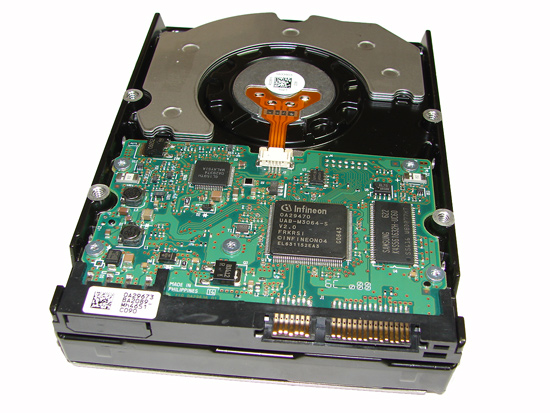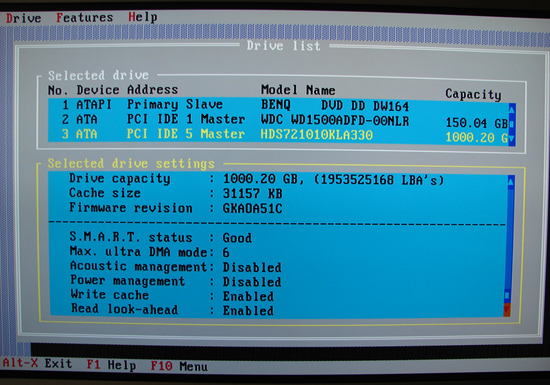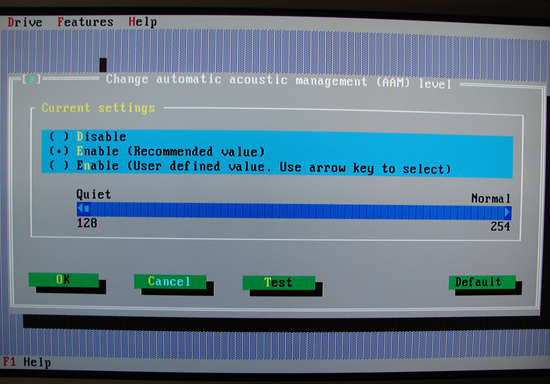Hitachi Deskstar 7K1000: Terabyte Storage arrives on the Desktop
by Gary Key on March 19, 2007 8:00 AM EST- Posted in
- Storage
Feature Set: Hitachi 7K1000

The external design of the Hitachi 7K1000 is the same as the majority of the TK or K series drives. The drive is based on the industry standard 3.5" form factor platform and would normally have the pertinent part number and warranty information embossed on a white sticker on the top of the casing. However, our O.E.M. sample was graciously provided by Dell and does not include this information. The only other differences between the O.E.M. and retail units will be the inclusion of an accessory kit, HD Feature Tool software (that can be downloaded separately), and the obligatory retail packaging.

The Deskstar 7K1000 ships with the Serial ATA data and power connector along with a space for a 4-pin Molex power connector designed for use with older ATX power supplies. Our early press photos included the 4-pin Molex connector but it appears the inclusion of it will be at the discretion of the O.E.M. or distribution locality. The 32MB of cache memory and controller logic is located on the outer side of the PCB.


Hitachi offers their excellent DOS based HD Feature Tool that allows the user to view the specifics of the drive and change certain options such as S.M.A.R.T., AAM, Power Management, and read and write optimizations. Our drive arrived with Automatic Acoustic Management turned on and set to the quietest level. We were able to easily set different levels or turn off AAM altogether. We found in our limited acoustical testing there was not a real difference between the 128 and 256 setting. Performance was slightly affected with AAM implemented but we felt the benefits of having it turned on outweighed any performance impact.
Hard Disk Test Comparison and Features
The Hitachi Deskstar 7K1000 is the first 1TB drive to ship based upon manufacturer's specifications with a 750 GB offering scheduled for availability next quarter. Of course the actual capacity of the drive is 931.5 GB, but due to the way manufacturers report capacity the drive is considered to be a 1TB offering. This drive is also Hitachi's first 3.5-inch hard drive to use PMR technology. Additional 1TB versions for the Enterprise and DVR/Set-Top markets will be released later this year.
The 7K1000 features a 5-platter 10-head perpendicular magnetic recording design with rotational speeds at 7200rpm. The cache size has been increased to 32MB from the previous 16MB on the TK series. Hitachi includes their ramp load/unload, advanced low-power idle modes, and thermal-fly height control technologies. This drive series also supports Native Command Queuing and hot-swap capabilities. The Hitachi Deskstar 7K1000 drives ship with a three year warranty and additional specifications can be found here.
The Hitachi 7K1000 drive we are reviewing today will be compared directly against the Seagate ST3750640AS 750GB and WD WD1500AHFD 150GB drives in our limited benchmark test suite. We have also included the results of drives from our previous articles and will provide additional results of the 7K1000 in our upcoming 500GB roundup.

The external design of the Hitachi 7K1000 is the same as the majority of the TK or K series drives. The drive is based on the industry standard 3.5" form factor platform and would normally have the pertinent part number and warranty information embossed on a white sticker on the top of the casing. However, our O.E.M. sample was graciously provided by Dell and does not include this information. The only other differences between the O.E.M. and retail units will be the inclusion of an accessory kit, HD Feature Tool software (that can be downloaded separately), and the obligatory retail packaging.

The Deskstar 7K1000 ships with the Serial ATA data and power connector along with a space for a 4-pin Molex power connector designed for use with older ATX power supplies. Our early press photos included the 4-pin Molex connector but it appears the inclusion of it will be at the discretion of the O.E.M. or distribution locality. The 32MB of cache memory and controller logic is located on the outer side of the PCB.


Hitachi offers their excellent DOS based HD Feature Tool that allows the user to view the specifics of the drive and change certain options such as S.M.A.R.T., AAM, Power Management, and read and write optimizations. Our drive arrived with Automatic Acoustic Management turned on and set to the quietest level. We were able to easily set different levels or turn off AAM altogether. We found in our limited acoustical testing there was not a real difference between the 128 and 256 setting. Performance was slightly affected with AAM implemented but we felt the benefits of having it turned on outweighed any performance impact.
Hard Disk Test Comparison and Features
| Hard Drive Specifications | |||
| Hitachi Deskstar 7K1000 1000GB HDS721010KLA330 | Seagate Barracuda 7200.10 750GB ST3750640AS | Western Digital Raptor 150GB WD1500ADFD | |
| Manufacturer's Stated Capacity: | 1000.2GB (1 Terabyte) | 750GB | 150GB |
| Operating System Stated Capacity: | 931.5 GB | 698.6 GB | 139.73 GB |
| Interface: | SATA 3Gb/s | SATA 3Gb/s | SATA 1.5Gb/s |
| Rotational Speed: | 7,200 RPM | 7,200 RPM | 10,000 RPM |
| Cache Size: | 32 MB | 16 MB | 16 MB |
| Average Latency: | 4.17 ms (nominal) | 4.16 ms (nominal) | 2.99 ms (nominal) |
| Read Seek Time: | 8.5 ms / 14ms Silent | 11 ms | 4.6 ms |
| Number of Heads: | 10 | 8 | 4 |
| Number of Platters: | 5 | 4 | 2 |
| Power Draw Idle / Load: | 8.1W / 12.8W | 9.3W / 12.6W | 9.19W / 10.02W |
| Power Draw Silent I / L: | 4.3W / 9.9W | - | - |
| Command Queuing: | Native Command Queuing | Native Command Queuing | Native Command Queuing |
| Warranty: | 3 Year - Retail or OEM | 5 Year - Retail or OEM | 5 Year - Retail or OEM |
The Hitachi Deskstar 7K1000 is the first 1TB drive to ship based upon manufacturer's specifications with a 750 GB offering scheduled for availability next quarter. Of course the actual capacity of the drive is 931.5 GB, but due to the way manufacturers report capacity the drive is considered to be a 1TB offering. This drive is also Hitachi's first 3.5-inch hard drive to use PMR technology. Additional 1TB versions for the Enterprise and DVR/Set-Top markets will be released later this year.
The 7K1000 features a 5-platter 10-head perpendicular magnetic recording design with rotational speeds at 7200rpm. The cache size has been increased to 32MB from the previous 16MB on the TK series. Hitachi includes their ramp load/unload, advanced low-power idle modes, and thermal-fly height control technologies. This drive series also supports Native Command Queuing and hot-swap capabilities. The Hitachi Deskstar 7K1000 drives ship with a three year warranty and additional specifications can be found here.
The Hitachi 7K1000 drive we are reviewing today will be compared directly against the Seagate ST3750640AS 750GB and WD WD1500AHFD 150GB drives in our limited benchmark test suite. We have also included the results of drives from our previous articles and will provide additional results of the 7K1000 in our upcoming 500GB roundup.










74 Comments
View All Comments
yacoub - Monday, March 19, 2007 - link
I've been curious how much help drives would get from a larger cache. What if smaller drives came with, say, 64MB of cache?JarredWalton - Monday, March 19, 2007 - link
Looking at the 750GB Seagate with its 16MB cache, there are definitely areas where the 32MB cache helps. Basically, with the larger capacities you need more cache to effectively handle all the data. Realistically, I'd say there's about 0% chance we'll see 64MB cache on smaller drives. When we're running 2TB drives, however....atomicacid55 - Monday, March 19, 2007 - link
I wish that the T7K500 could be reviewed in this. After all, that's the current challenger to the 7200.10, and if you read STR, the consensus is that it's an overall faster drive than the 7200.10. Every drive manufacturer tends to set its own trends in performance, and I personally believe it's more useful to have a comparison of the 7K1000 with its sibling rather than only against other brands.Gary Key - Monday, March 19, 2007 - link
Hitachi is finally sending us a T7K500. We will have a 500GB roundup with the latest drives from WD, Seagate, Samsung, and Hitachi in April.dm0r - Monday, March 19, 2007 - link
Never thought a 7200 RPM drive could be very competitive to a 10000 one...Thanks to its 32 Mb Cache.Loved the acoustics test, it shows a very quiet drive.With this new drives coming to the market, Western Digital will have to think about its raptors Overpriced drives and low its prices.Very good review.A question: How many Hitachi drives will be lauched with Perpendicular recording like this and what capacities?
Justin Case - Wednesday, March 21, 2007 - link
Higher areal density means more data can be read per rotation, so it could even be faster in terms of STR. But 7200 RPM drives will still have higher latency than 10k models, of course. The only way to overcome that would be to add more heads (ex., 2 per platter).bkiserx7 - Monday, March 19, 2007 - link
...wonder what a perpindicular raptor will do one day?crimson117 - Monday, March 19, 2007 - link
Attack prey from right angles?cruzer - Monday, March 19, 2007 - link
On page 10, "As stated in the article, we believe leaving AAM and NCQ turned provides the best experience with this drive."Do you mean turned on or off?
tuteja1986 - Tuesday, March 20, 2007 - link
I really want 3 of them for raid 5 setup :)